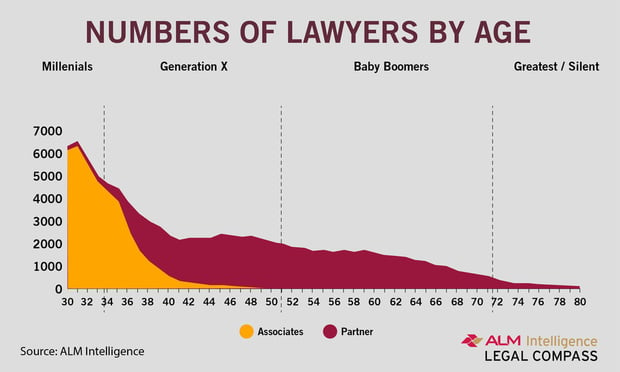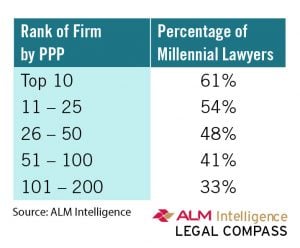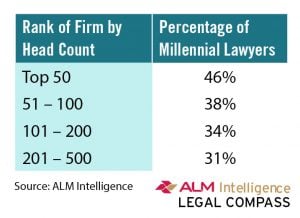Where the Millennials Are: Tracking the Generations in Big Law
The wave of millennial lawyers is building much faster at some law firms and in some markets than others.
November 06, 2017 at 04:17 PM
5 minute read
 Fotolia
Fotolia This story is part of a series exploring how law firms and others in the legal industry are adapting to manage their millennial workers, from recruitment and real estate to training and technology and beyond. Read our overview here.
 Millennials make up the largest generational group among lawyers at large and midsize firms, although most of them are still associates.
Millennials make up the largest generational group among lawyers at large and midsize firms, although most of them are still associates.
Data collected by ALM Intelligence shows that the millennials (ages 18 to 36) now outnumber lawyers from Generation X (ages 37 to 52) at firms in the Am Law 200 and The National Law Journal's NLJ 500. And they far outnumber baby boomers (ages 53 to 71).
The numbers starkly illustrate the reality facing law firm leaders: Millennials will soon take over the legal profession in sheer numbers—and soon enough they'll dominate leadership positions and partnerships too.

Millennials make up 47,000, or 43 percent, of lawyers at the nearly 400 firms included in the ALI data. They comprise 88 percent of associates, and just 5 percent of partners.
Generation X has the next greatest number of lawyers, at 36,600. But the group makes up 52 percent of partners.
Baby boomers still have a noticeable presence at these firms, with about 24,000 lawyers, but they've become less dominant than Gen X in the partnership ranks, making up 40 percent of partners.
The Silent Generation, also known as traditionalists, and the Greatest Generation, which came before them, have mostly retired. There are fewer than 1,700 lawyers from those generations left at law firms, and they make up just 2 percent of partners.
 FLOCKING TO CALIFORNIA
FLOCKING TO CALIFORNIA
Generally, if you're a millennial lawyer, you want to be in a large city, or in California. Of the 10 largest metro areas by GDP, seven were also within the top 10 locations by percentage lawyers who are millennials (not including metro areas with less than 100 lawyers).
Also in that top 10 were San Jose, San Diego and Fresno, which are ranked 14th, 17th and 63rd for GDP. So with those three included, California cities make up five of the top 10 for millennial lawyers.
The area with the highest concentration of millennial lawyers was San Jose, at 47 percent. New York came in second at 45 percent, and Boston, with 44 percent millennials, was third.
Chicago, the third largest metro area, fell just outside the top 10, with millennials accounting for 38 percent of lawyers at the surveyed firms.
But two of the largest metro area that fell further behind on their share of millennial lawyers were Philadelphia and Atlanta. These two areas are the eighth and 10th largest by GDP, but ranked 17th and 20th, respectively, for the percentage of millennial lawyers they have.
 MORE MONEY, MORE MILLENNIALS
MORE MONEY, MORE MILLENNIALS
Employing millennials appears to go hand-in-hand with profitability—illustrating how Big Law continues to use rainmakers to land major clients and young lawyers to put in long hours serving them. At the top 10 firms by profits per equity partner, 61 percent of lawyers were millennials. That percentage decreased with each tier of profitability.
Among firms outside the top 100 most profitable, the percentage of millennial lawyers was just 33.
Millennial lawyers also appear to be more populous at law firms with the largest head counts. The top 50 firms by head count employ the greatest proportion of millennials by a long shot, as 46 percent of their attorneys belong to that generation. These firms would tend to have the highest leverage, leading to a greater population of young, millennial lawyers.
 The next 50 largest firms had 38 percent millennials. Firms 101 to 200 by head count were 34 percent millennial. And at the other 300 firms included in the data, 31 percent of lawyers were millennials.
The next 50 largest firms had 38 percent millennials. Firms 101 to 200 by head count were 34 percent millennial. And at the other 300 firms included in the data, 31 percent of lawyers were millennials.
Millennials made up half or more of the lawyer head count at 37 law firms out of 380 included in the data.
FIRM BY FIRM
The interactive chart below breaks down percentages of millennial lawyers by firm and by office. Hover over each firm to view the data.
METHODOLOGY
ALM Intelligence compiled this data using information available on websites of law firms in the Am Law 200 and NLJ 500. After gathering publicly available lawyer biographical data from those websites, ALI used their graduation dates from law school to estimate ages of all lawyers, based on the average age of new law school graduates, allowing lawyers to be divided into generational groups. Law firms with insufficient data on their websites were not included.
As this data makes use of firm-reported data and age estimates, it may not be exact for each firm listed.
This content has been archived. It is available through our partners, LexisNexis® and Bloomberg Law.
To view this content, please continue to their sites.
Not a Lexis Subscriber?
Subscribe Now
Not a Bloomberg Law Subscriber?
Subscribe Now
NOT FOR REPRINT
© 2025 ALM Global, LLC, All Rights Reserved. Request academic re-use from www.copyright.com. All other uses, submit a request to [email protected]. For more information visit Asset & Logo Licensing.
You Might Like
View All
Are Counsel Ranks Getting 'Squeezed' as Nonequity and Associate Pay Grows?
5 minute read
AI's Place in Big Law Broadens, As Firms Embrace Fresh Uses of the Technology
Trending Stories
- 1Democracy in Focus: New York State Court of Appeals Year in Review
- 2In Vape Case, A Debate Over Forum Shopping
- 3SDNY Criminal Division Deputy Chief Returns to Debevoise
- 4Brownstein Adds Former Interior Secretary, Offering 'Strategic Counsel' During New Trump Term
- 5Tragedy on I-95: Florida Lawsuit Against Horizon Freight System Could Set New Precedent in Crash Cases
Who Got The Work
J. Brugh Lower of Gibbons has entered an appearance for industrial equipment supplier Devco Corporation in a pending trademark infringement lawsuit. The suit, accusing the defendant of selling knock-off Graco products, was filed Dec. 18 in New Jersey District Court by Rivkin Radler on behalf of Graco Inc. and Graco Minnesota. The case, assigned to U.S. District Judge Zahid N. Quraishi, is 3:24-cv-11294, Graco Inc. et al v. Devco Corporation.
Who Got The Work
Rebecca Maller-Stein and Kent A. Yalowitz of Arnold & Porter Kaye Scholer have entered their appearances for Hanaco Venture Capital and its executives, Lior Prosor and David Frankel, in a pending securities lawsuit. The action, filed on Dec. 24 in New York Southern District Court by Zell, Aron & Co. on behalf of Goldeneye Advisors, accuses the defendants of negligently and fraudulently managing the plaintiff's $1 million investment. The case, assigned to U.S. District Judge Vernon S. Broderick, is 1:24-cv-09918, Goldeneye Advisors, LLC v. Hanaco Venture Capital, Ltd. et al.
Who Got The Work
Attorneys from A&O Shearman has stepped in as defense counsel for Toronto-Dominion Bank and other defendants in a pending securities class action. The suit, filed Dec. 11 in New York Southern District Court by Bleichmar Fonti & Auld, accuses the defendants of concealing the bank's 'pervasive' deficiencies in regards to its compliance with the Bank Secrecy Act and the quality of its anti-money laundering controls. The case, assigned to U.S. District Judge Arun Subramanian, is 1:24-cv-09445, Gonzalez v. The Toronto-Dominion Bank et al.
Who Got The Work
Crown Castle International, a Pennsylvania company providing shared communications infrastructure, has turned to Luke D. Wolf of Gordon Rees Scully Mansukhani to fend off a pending breach-of-contract lawsuit. The court action, filed Nov. 25 in Michigan Eastern District Court by Hooper Hathaway PC on behalf of The Town Residences LLC, accuses Crown Castle of failing to transfer approximately $30,000 in utility payments from T-Mobile in breach of a roof-top lease and assignment agreement. The case, assigned to U.S. District Judge Susan K. Declercq, is 2:24-cv-13131, The Town Residences LLC v. T-Mobile US, Inc. et al.
Who Got The Work
Wilfred P. Coronato and Daniel M. Schwartz of McCarter & English have stepped in as defense counsel to Electrolux Home Products Inc. in a pending product liability lawsuit. The court action, filed Nov. 26 in New York Eastern District Court by Poulos Lopiccolo PC and Nagel Rice LLP on behalf of David Stern, alleges that the defendant's refrigerators’ drawers and shelving repeatedly break and fall apart within months after purchase. The case, assigned to U.S. District Judge Joan M. Azrack, is 2:24-cv-08204, Stern v. Electrolux Home Products, Inc.
Featured Firms
Law Offices of Gary Martin Hays & Associates, P.C.
(470) 294-1674
Law Offices of Mark E. Salomone
(857) 444-6468
Smith & Hassler
(713) 739-1250











